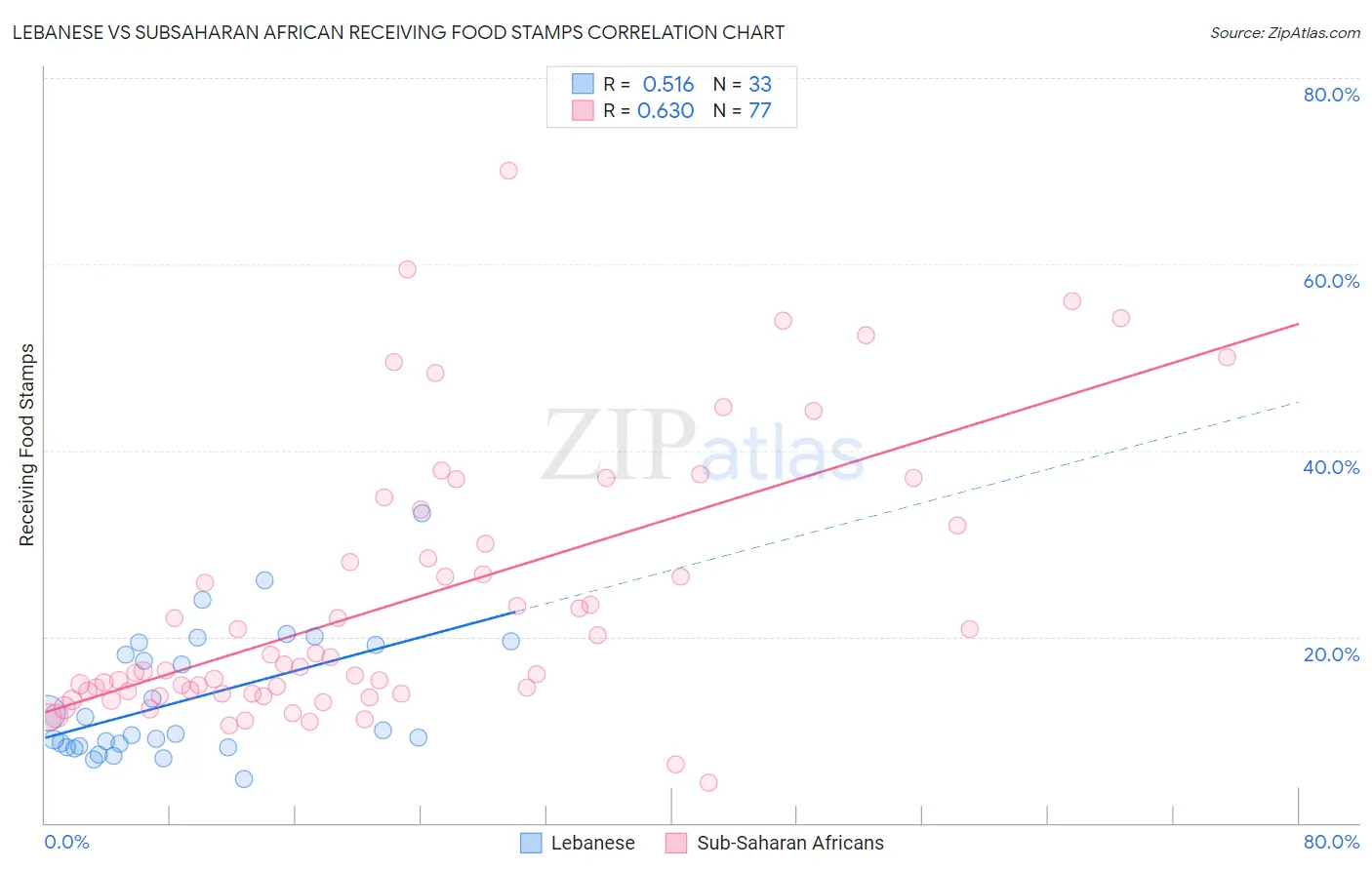Lebanese vs Subsaharan African Receiving Food Stamps
COMPARE
Lebanese
Subsaharan African
Receiving Food Stamps
Receiving Food Stamps Comparison
Lebanese
Sub-Saharan Africans
11.1%
RECEIVING FOOD STAMPS
81.6/ 100
METRIC RATING
153rd/ 347
METRIC RANK
14.1%
RECEIVING FOOD STAMPS
0.3/ 100
METRIC RATING
255th/ 347
METRIC RANK
Lebanese vs Subsaharan African Receiving Food Stamps Correlation Chart
The statistical analysis conducted on geographies consisting of 400,242,297 people shows a substantial positive correlation between the proportion of Lebanese and percentage of population receiving government assistance and/or food stamps in the United States with a correlation coefficient (R) of 0.516 and weighted average of 11.1%. Similarly, the statistical analysis conducted on geographies consisting of 506,389,803 people shows a significant positive correlation between the proportion of Sub-Saharan Africans and percentage of population receiving government assistance and/or food stamps in the United States with a correlation coefficient (R) of 0.630 and weighted average of 14.1%, a difference of 26.6%.

Receiving Food Stamps Correlation Summary
| Measurement | Lebanese | Subsaharan African |
| Minimum | 4.7% | 4.3% |
| Maximum | 33.2% | 70.0% |
| Range | 28.5% | 65.7% |
| Mean | 13.3% | 23.8% |
| Median | 9.5% | 16.8% |
| Interquartile 25% (IQ1) | 8.2% | 13.9% |
| Interquartile 75% (IQ3) | 19.2% | 31.0% |
| Interquartile Range (IQR) | 11.0% | 17.1% |
| Standard Deviation (Sample) | 6.8% | 14.4% |
| Standard Deviation (Population) | 6.7% | 14.3% |
Similar Demographics by Receiving Food Stamps
Demographics Similar to Lebanese by Receiving Food Stamps
In terms of receiving food stamps, the demographic groups most similar to Lebanese are Immigrants from Spain (11.1%, a difference of 0.020%), Immigrants from Kazakhstan (11.1%, a difference of 0.020%), Armenian (11.1%, a difference of 0.060%), Immigrants from Argentina (11.2%, a difference of 0.31%), and Soviet Union (11.1%, a difference of 0.38%).
| Demographics | Rating | Rank | Receiving Food Stamps |
| Taiwanese | 84.2 /100 | #146 | Excellent 11.0% |
| Whites/Caucasians | 83.9 /100 | #147 | Excellent 11.1% |
| Immigrants | South Eastern Asia | 83.3 /100 | #148 | Excellent 11.1% |
| Brazilians | 83.2 /100 | #149 | Excellent 11.1% |
| Soviet Union | 83.1 /100 | #150 | Excellent 11.1% |
| Immigrants | Spain | 81.7 /100 | #151 | Excellent 11.1% |
| Immigrants | Kazakhstan | 81.7 /100 | #152 | Excellent 11.1% |
| Lebanese | 81.6 /100 | #153 | Excellent 11.1% |
| Armenians | 81.4 /100 | #154 | Excellent 11.1% |
| Immigrants | Argentina | 80.4 /100 | #155 | Excellent 11.2% |
| Immigrants | Afghanistan | 75.6 /100 | #156 | Good 11.3% |
| Immigrants | Lebanon | 75.2 /100 | #157 | Good 11.3% |
| Immigrants | Bosnia and Herzegovina | 72.6 /100 | #158 | Good 11.3% |
| Immigrants | Oceania | 70.4 /100 | #159 | Good 11.4% |
| French Canadians | 69.5 /100 | #160 | Good 11.4% |
Demographics Similar to Sub-Saharan Africans by Receiving Food Stamps
In terms of receiving food stamps, the demographic groups most similar to Sub-Saharan Africans are Marshallese (14.1%, a difference of 0.010%), Japanese (14.1%, a difference of 0.020%), Arapaho (14.1%, a difference of 0.12%), Immigrants from Ghana (14.1%, a difference of 0.20%), and Creek (14.1%, a difference of 0.33%).
| Demographics | Rating | Rank | Receiving Food Stamps |
| Immigrants | Laos | 0.7 /100 | #248 | Tragic 13.8% |
| Indonesians | 0.6 /100 | #249 | Tragic 13.9% |
| Immigrants | Cambodia | 0.5 /100 | #250 | Tragic 13.9% |
| Yaqui | 0.5 /100 | #251 | Tragic 13.9% |
| Ghanaians | 0.5 /100 | #252 | Tragic 14.0% |
| Spanish Americans | 0.4 /100 | #253 | Tragic 14.0% |
| Marshallese | 0.3 /100 | #254 | Tragic 14.1% |
| Sub-Saharan Africans | 0.3 /100 | #255 | Tragic 14.1% |
| Japanese | 0.3 /100 | #256 | Tragic 14.1% |
| Arapaho | 0.3 /100 | #257 | Tragic 14.1% |
| Immigrants | Ghana | 0.3 /100 | #258 | Tragic 14.1% |
| Creek | 0.3 /100 | #259 | Tragic 14.1% |
| Central Americans | 0.3 /100 | #260 | Tragic 14.1% |
| Immigrants | Congo | 0.3 /100 | #261 | Tragic 14.1% |
| Paiute | 0.2 /100 | #262 | Tragic 14.3% |